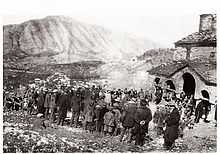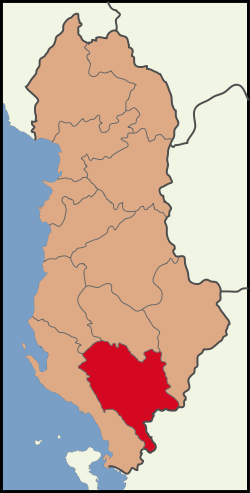Poliçan, Gjirokastër
| Poliçan Polytsani | |
|---|---|
| Settlement | |
| Nickname(s): The Bride of the Pogoni region[1] | |
 Poliçan | |
| Coordinates: 40°7′53″N 20°21′2″E / 40.13139°N 20.35056°ECoordinates: 40°7′53″N 20°21′2″E / 40.13139°N 20.35056°E | |
| Country |
|
| County | Gjirokastër |
| District | Gjirokastër |
| Municipality | Pogon |
| Time zone | Central European Time (UTC+1) |
| • Summer (DST) | CEST (UTC+2) |
Poliçan (Greek: Πολύτσανη, Polytsani) is a town in Gjirokastër District, southern Albania.[2] It is within the wider Pogoni region that stretches in both Greece and Albania.[3] Polican is the municipal center of Pogon municipality in Albania.
History
Antiquity and Byzantine period
In classical antiquity the region was inhabited by the Chaonians,[4] one of the three major Greek tribes that inhabited ancient Epirus.[5] Polican was identified with the Chaonian settlement Politeiani (Greek: Πολιτειανή) also known as Polyani (Greek: Πολυανή). The name appears to be borrowed from the nearby mountain Polyainos.[4] Ancient coins depicting Alexander the Great have been unearthed in Poliçan.[6]
The ancient name has changed to the present form (Polyts(i)ani) during the Slavic invasion (7th-8th century).[4] In the late Byzantine period (11th-15th century) two Christian Orthodox monasteries were erected next to Polican.[4] After the Fall of Constantinople in the Fourth Crusade (1204), Polican became part of the Greek Despotate of Epirus and refuge for various Byzantine noble families.[7]
Ottoman period
At the period of Ottoman occupation, that started in mid-15th century, Polican enjoyed a privileged semi-autonomous status which lead to economic and cultural flourishing.[7] The settlement was included in the Koinon of Zagori, although geographically it was not part of the Zagori region, but belonged to the Pogoni villages.[3]

In the early 16th century two significant church buildings were erected in the town: Saint Athanasius (1513) and Saint Demetrius (1526). Both of them display unique features of early post-Byzantine art.[8] A Greek school was founded in 1672 by the local Orthodox missionary Sophianos next to the church of Saint Athanasius.[9] The school attracted also students from the nearby regions next to Gjirokastër (Zagori and Riza).[10]
A second school started operating in 1750, sponsored by a local businessman and benefactor.[9] Greek education was expanded with the foundation of two secondary level schools in 1866, in addition to a boys' and a girls' school in 1866 and 1874 respectively.[11] The local educational institutions became renowned to such a degree that their graduates were eligible for admission to any Greek college in the Ottoman capital Constantinople (Istanbul) without qualifying examinations.[12] The schools of Polican were financed by the local community and especially by local businessmen and benefactors as well as by the town's diaspora.[13]
20th century
Polican and the rest of the settlements in the Pogon municipality became part of Albania in the 1920s.[14] In 1940, when Axis Italy launched a failed invasion against Greece from Albanian territory during World War II, the town came under the control of the II Army Corps of the Greek forces.[15]
The Greek communities that reside in Pogon have a recognized minority status by the Albanian state.[16] A Greek elementary school is currently operating in Polican.[17]
Demographics
In 1913 the population of Polican was 1,650 (Greek census).[18] It reached ca. 2,500 inhabitants in the 1960s,[19] but it decreased to 559 in 1989.[20]
Geography and culture
Polican is located on the slopes of Mount Nemërçkë, 13 km (8 mi) from the Greek-Albanian border.[1][21] It is the northernmost settlement of the Pogoni region, which is divided between Greece (40 villages) and Albania (7 villages).[3][22][23] In Polican, along with the rest of the Pogoni region, polyphonic singing is part of the local musical tradition.[22]
Notable people
- Sophianos (-1711), Greek-Orthodox bishop and scholar.
References
- ↑ 1.0 1.1 Καλανταρίδου, Σοφία. "Αποστολή αλληλεγγύης στην Πολύτσανη Πωγωνίου". enet.gr (in Greek). Eleftherotypia. Retrieved 3 February 2015.
- ↑ "Location of Derviçan". Retrieved 3 September 2010.
- ↑ 3.0 3.1 3.2 Giakoumis, 2009, p. 15
- ↑ 4.0 4.1 4.2 4.3 Giakoumis, 2009, p. 12
- ↑ Boardman, John; Hammond, Nicholas Geoffrey Lemprière (1982). The Cambridge Ancient History - The Expansion of the Greek World, Eighth to Sixth Centuries B.C., Part 3: Volume 3 (Second ed.). Cambridge, United Kingdom: Cambridge University Press. pp. 430, 434. ISBN 0-521-23447-6.
- ↑ Hammond, 1967, p. 722
- ↑ 7.0 7.1 Giakoumis, 2009, p. 141
- ↑ Giakoumis, 2009, p. 139
- ↑ 9.0 9.1 Koltsida, 2008, p. 131
- ↑ Koltsida, 2008, p. 197
- ↑ Koltsida, 2008, p. 229
- ↑ Koltsida, 2008, p. 235
- ↑ Koltsida, 2008, pp. 281–285
- ↑ (Eds.), Andreas Hemming ... (2010). Albania : family, society and culture in the 20th century. Münster [u.a.]: LIT. p. 103. ISBN 9783643501448.
- ↑ Carr, John C. (2013). The defence and fall of Greece 1940-1941. pp. 82–83. ISBN 9781781591819.
- ↑ Tziovas, 2003, p. 196
- ↑ "Second Report Submitted by Albania Pursuant to Article 25, Paragraph 2 of the Framework onvention for the Protection of National Minorities". Council of Europe. p. 62. Retrieved 7 February 2015.
- ↑ Koltsida, 2008, p. 100
- ↑ Hammond, 1967, p. 29
- ↑ Kallivretakis, Leonidas (1995). "Η Ελληνική Κοινότητα της Αλβανίας υπό το Πρίσμα της Ιστορικής Γεωγραφίας και Δημογραφίας [The Greek Community of Albania in Terms of Historical Geography and Demography]" (in Greek). Εκδόσεις Σιδέρης. p. 57. Retrieved 2 February 2015.
- ↑ Hammond, 1967, p. 215
- ↑ 22.0 22.1 Tziovas, 2003, p. 196
- ↑ Hammond, 1967, p. 213
Sources
- Georgios, Giakoumis (2009). Δύο Πρώιμα Μετα-Βυζαντινά Μνημεία και ο Ζωγραφικός τους Διάκοσμος στο Πωγώνι [Two Early Post-Byzantine Monuments and their Internal Enivironment in Pogoni] (pdf) (in Greek). University of Ioannina. Retrieved 16 December 2014. (PhD Thesis)
- Hammond, Nicholas Geoffrey Lemprière (1967). Epirus: The Geography, the Ancient Remains, the History and Topography of Epirus and Adjacent Areas. Clarendon P.
- Koltsida, Athina (2008). Η Εκπαίδευση στη Βόρειο Ήπειρο κατά την Ύστερη Περίοδο της Οθωμανικής Αυτοκρατορίας [Education in Northern Epirus during the Latter Ottoman Period] (pdf) (in Greek). Aristotle University of Thessaloniki. Retrieved 16 December 2012. (PhD Thesis)
- Tziovas, edited by Dimitris (2003). Greece and the Balkans: Identities, Perceptions and Cultural Encounters since the Enlightenment. Aldershot, England: Ashgate. ISBN 9780754609988.
- ΖΩΤΟΥ, ΜΕΝΕΛΑΟΥ; ΓΙΑΝΝΑΡΟΥ, ΧΡΙΣΤΟΦΟΡΟΥ. Η ΠΟΛΥΤΣΑΝΗ ΤΗΣ ΒΟΡΕΙΟΥ ΗΠΕΙΡΟΥ. ΕΚΔΟΣΕΙΣ, ΙΩΑΝΝΙΝΑ, 1989.
- Politsanitika Nea Newspaper, Tel. +30 210 5238058 (Greek)
External links
Traditional songs
- Εψές Προψές Απέρασα [One Night, Two Nights Ago I Dropped by].
- Του Γιοφυριού της Άρτας [Song of the Bridge of Arta].
Website
| |||||||||||||||||||||
